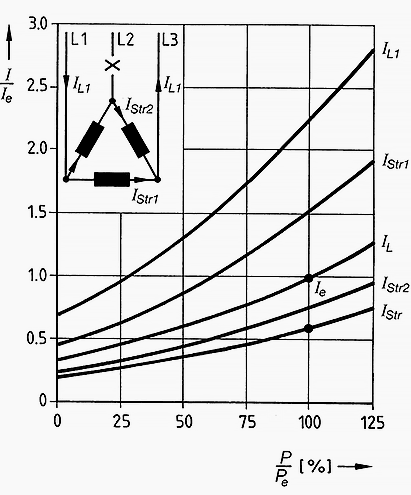Articles
Beauty of electronics
Electrical
Electronics
Technical Articles
Tutorials
When a 3-phase motor expirience phase failure, what a mess
4:53 PMWhen a 3-phase motor expirience phase failure, what a mess: When a 3-phase motor expirience phase failure, what a mess… (pho...
When a 3-phase motor expirience phase failure, what a mess:
Phase failure:
A phase failure is an interruption of a single conductor. The motor then continues running with two phases and can suffer damage. The cause is, for example, blown fuse. Small to medium sized motors are mostly stator critical – this means that only the stator can be damaged.
It has to be differentiated between:
- Motors in Star Connection.
- Motors in Delta Connection.
Motors in star connection:
These motors are not put at risk by a phase failure. As shown in Figure 1, the currents in the motor windings, during disturbed and undisturbed operation at the failure of a single conductor, equal the currents in the other two. Due to the increasing current, a higher power loss occurs in both live windings.
On the whole, the motor is running cool, since the third cold winding causes a temperature compensation.
In case of an overcurrent, a protective current detector trips in time. Small to medium sized (stator critical) motors in star connection are usually not put at risk during a phase failure.

Where,
- Ie IStr – Currents in the phases and windings in undisturbed operation
- Ie1 IStr1 – Currents in the phases and windings in disturbed operation
Motors in delta connection:
In delta connection, the phase currents in undisturbed operation are lower by a factor 1/√3 than the currents in the windings ISTR = 0.58 In.
During the failure of a phase, the current increases for electromagnetic reasons by approximately 50%, as shown in Figure 2. In the other two windings, which are now switched in series, the current falls to approximately 67%.
This phenomenon occurs because the motor keeps the power transmitted to the shaft practically constant. The absolute current increase in the windings and in both intact phases depends on the load applied.

Where,
- IL IStr – Currents in the phases and windings in undisturbed operation
- IL1 IStr1 IStr2 – Currents in the phases and windings in disturbed operation
Since the currents in the windings are not equal, they do not warm up equally either. Since heat is exchanged between individual windings and between windings and the iron body, the warming up of the stator is proportional to the sum of all losses in all windings.
In general, the following applies for motors with an output of //
Pe ≤ 10kW They do not require a special phase failure protection, as long as the two-phase trip current is ≤ 1.25 Ie . In this case, the warming up is, at the most equal, to the warming up during a symmetrical, three-phase load.
Pe ≥ 10 kW For these motors, a motor protector with phase failure protection or a quick-response electronic protector is recommended. Besides electrical protection, the fast cut-out also contributes to reduced stress on the bearings.
Many companies and electricity company’s factory regulations demand phase-failure sensitive motor protection mainly for bigger drives, or for systems with an increased safety requirement.
For a single phase feed of the stator, the rotor losses are considerably higher compared to a symmetrical feed. This can represent an additional danger, especially for rotor critical motors.
Reference // Basics for practical operation – Motor protection by Rockwell Automation






0 comments